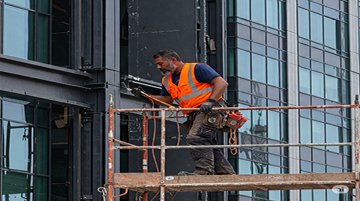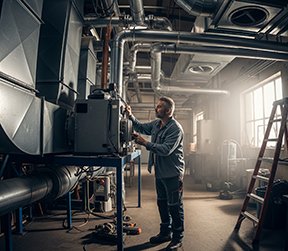Published: June 30, 2025 | Updated: October 23, 2025
Published: June 30, 2025 | Updated: October 23, 2025
Why Exterior Building Maintenance Matters for Long-Term Building Care
 The initial impression of a commercial property, whether an office complex or a manufacturing plant, rests significantly on its external appearance. Understanding the undeniable importance of exterior building maintenance extends far beyond mere aesthetics. This proactive approach forms a vital defense against environmental stressors and the natural course of time, representing a strategic allocation of resources toward the building's durability, security, and overall worth.
The initial impression of a commercial property, whether an office complex or a manufacturing plant, rests significantly on its external appearance. Understanding the undeniable importance of exterior building maintenance extends far beyond mere aesthetics. This proactive approach forms a vital defense against environmental stressors and the natural course of time, representing a strategic allocation of resources toward the building's durability, security, and overall worth.
The Importance of Proactive Exterior Maintenance
While a building’s exterior might currently present a satisfactory appearance, neglecting consistent preventative maintenance invites future complications. Consider the analogy of a minor plumbing leak. Initially, it may seem insignificant, yet over time, the resulting damage accumulates, eventually leading to substantial repair expenses or even catastrophic structural failures. This principle directly applies to the various systems and surfaces that comprise a building's exterior envelope.
For instance, water infiltration, often originating from minute cracks within the façade, can insidiously permeate building materials. This seemingly small issue can escalate into significant structural compromise, fostering mold proliferation and creating potential electrical hazards. Similarly, a roof that lacks proper upkeep can develop leaks, resulting in damaged ceilings, operational disruptions, and compromised interior spaces. Therefore, a proactive stance on exterior maintenance mitigates these risks before they manifest into costly and disruptive problems.
Key Benefits of Exterior Building Maintenance
As previously noted, one primary advantage of regular exterior maintenance involves the early detection and resolution of minor issues before they escalate into major concerns. However, the benefits of a well-maintained exterior extend considerably beyond this preventative aspect, positively influencing various facets of a property and its operations.
Elevated Curb Appeal and Occupant Attraction
A clean and meticulously maintained property significantly enhances its curb appeal. For those managing apartment complexes or similar residential buildings, consistent upkeep of the structures directly contributes to attracting prospective tenants. The visual presentation of the buildings creates a crucial first impression that can sway potential residents. Conversely, a neglected exterior can deter individuals, regardless of the property's other attributes.
Consider the common experience of encountering a dilapidated commercial building. Even if a need exists for the products or services offered within, the unappealing exterior can create a negative perception, discouraging potential customers from entering. This same principle applies to various establishments, such as senior living centers, where the condition of the physical building can heavily influence perceptions of the facility's overall quality of care and service. A well-maintained exterior conveys professionalism, stability, and attention to detail.
Bolstered Safety and Security
Safety represents a paramount concern that underscores the necessity of regular exterior care. Over time, elements such as hanging gutters, sagging roofs, broken windows, and a deteriorating foundation pose significant safety risks. These seemingly minor issues can escalate into hazardous situations for occupants, visitors, and even passersby. Addressing these concerns promptly through regular maintenance minimizes the likelihood of accidents and liabilities.
Enhanced Operational Efficiency
The condition of a building's exterior directly impacts the efficiency and productivity of its occupants. When employees must consistently navigate or work around problematic conditions, such as leaks, drafts, or unsafe exterior areas, their focus and effectiveness diminish. A well-maintained exterior creates a more comfortable and secure working environment, fostering improved morale and productivity.
Regulatory Compliance
In numerous instances, demonstrating adherence to local, state, and federal regulations necessitates consistent building maintenance. Certain regulations mandate specific upkeep standards to ensure safety and prevent hazards. Regular exterior maintenance helps property owners and managers remain compliant with these legal requirements, avoiding potential penalties and ensuring operational continuity.
Discover how streamlined maintenance processes can elevate production. Learn more.
Essential Roles in Exterior Building Maintenance Teams
Effective exterior building maintenance necessitates a team of skilled professionals capable of addressing a diverse range of tasks. The following outlines some crucial roles involved in preserving the integrity and appearance of a building's exterior:
Roofing Specialists
These professionals serve as the frontline defense against the elements. Their duties encompass:
- Regular inspections for damage, wear, and tear.
- Repairing leaks and replacing damaged shingles or tiles.
- Gutter cleaning and maintenance to prevent water damage.
- Installing new roofing systems when required.
- Addressing issues such as ice and hail damage.
Exterior Cleaning and Painting Professionals
These specialists focus on maintaining and enhancing the building's aesthetic appeal. Their responsibilities include:
- Pressure washing to eliminate dirt, grime, and mold.
- Window cleaning for both interior and exterior surfaces.
- Painting and repainting the building's exterior to protect surfaces and improve appearance.
- Caulking and sealing to prevent water infiltration.
Masonry and Concrete Repair Technicians
These technicians possess the specialized skills to care for masonry and concrete structures:
- Inspecting brick, stone, and concrete for cracks, chips, and deterioration.
- Repairing damaged masonry using appropriate techniques.
- Waterproofing basements and foundations to prevent moisture problems.
- Pointing and repointing to seal gaps and protect masonry.
Landscaping and Grounds Maintenance Crews
The exterior surroundings play a vital role in the building's overall presentation and functionality. This team's tasks include:
- Mowing lawns, trimming hedges, and maintaining shrubs.
- Removing debris, weeds, and litter.
- Planting and caring for flowers and other landscaping elements.
- Maintaining walkways, patios, and driveways.
- Handling snow removal and de-icing during winter months.
Carpentry and Exterior Woodwork Specialists
Wooden components on the building's exterior require specialized care. These professionals:
- Repair and replace rotted or damaged wood.
- Paint and stain wooden surfaces to protect them from the elements.
- Install new exterior woodwork as needed.
HVAC Technicians
 While primarily focused on indoor climate control, HVAC systems often include exterior components that require attention. Technicians:
While primarily focused on indoor climate control, HVAC systems often include exterior components that require attention. Technicians:
- Maintain and repair rooftop units.
- Inspect and clean condenser coils.
- Ensure proper drainage of condensate lines.
- Address issues with outdoor equipment.
Preventing pest infestations on the building's exterior is crucial for maintaining a healthy environment. Pest control experts:
- Identify and eliminate pest infestations.
- Apply preventive treatments to deter pests.
- Inspect for signs of infestation and recommend solutions.
Discover how streamlined maintenance processes can elevate production. Learn more.
Creating a Strategic Exterior Maintenance Plan
Initiating a successful exterior building maintenance program necessitates a structured and systematic approach. The initial step involves conducting a thorough assessment of the building's exterior, meticulously identifying all components, materials, and their current condition. Factors such as the building's age, geographical location, and prevailing climate significantly influence the determination of the most appropriate maintenance schedule. For instance, properties situated in coastal regions may require more frequent inspections due to the corrosive effects of saltwater exposure.
Following a comprehensive assessment, the next crucial step involves prioritizing maintenance tasks based on their criticality and frequency. Essential tasks typically include regular inspections, consistent cleaning protocols, timely repairs, and proactive/preventative measures. These would include routine cleaning of gutters and downspouts. This plays a vital role in preventing potential water damage, while diligently sealing cracks and joints effectively safeguards against moisture infiltration. Establishing a clear chain of responsibility, assigning specific tasks to designated individuals or teams, ensures accountability and efficient execution of the maintenance plan.
The successful implementation of a maintenance plan hinges on engaging and adequately training skilled technicians and workers. Clear communication regarding team objectives and departmental goals fosters a cohesive and effective maintenance operation. Subsequently, the plan requires diligent implementation, often involving the use of work orders, thorough quality reviews, and regular discussions to facilitate necessary adjustments and the establishment of evolving objectives.
How CMMS Software Supports Exterior Maintenance
Computerized Maintenance Management System (CMMS) software offers substantial benefits for managing exterior building maintenance, mirroring its advantages in other maintenance domains. It serves as a centralized repository for all pertinent information, facilitates efficient workflow management, and provides valuable data analytics for informed decision-making processes. A CMMS enables the scheduling of preventive maintenance tasks, comprehensive tracking of work orders, efficient management of inventory, and the generation of insightful reports. By digitizing maintenance records, organizations ensure operational continuity, even in the event of personnel changes.
Furthermore, a CMMS meticulously documents the building's maintenance history, providing essential records for audits and regulatory compliance. The system allows for the generation of numerous reports specifically concerning exterior maintenance activities. By diligently tracking the cycles of preventive maintenance, potential problems can be proactively identified and addressed. Beyond record-keeping, a CMMS provides oversight on resource allocation, encompassing both labor and inventory. This enhanced visibility allows for greater control over budgeting through detailed reports on inventory costs and the ability to assess the efficiency of the maintenance team.
FAQs
Why is exterior building maintenance important?
Exterior maintenance protects a building from environmental damage, enhances curb appeal, and preserves structural integrity.
What are the risks of neglecting exterior maintenance?
Neglected exteriors can lead to water damage, mold growth, structural issues, safety hazards, and costly repairs.
How does exterior maintenance impact building safety and efficiency?
Regular upkeep reduces risks from damaged roofs, gutters, and walkways while creating a safe, productive environment for occupants.
Who is typically involved in exterior building maintenance?
Key roles include roofing specialists, painters, masonry and concrete technicians, landscaping crews, carpenters, HVAC technicians, and pest control experts.
How should a strategic exterior maintenance plan be created?
Assess the building’s condition, prioritize critical tasks, schedule preventive maintenance, assign responsibilities, and train skilled personnel.
How can CMMS software support exterior building maintenance?
CMMS software schedules preventive tasks, tracks work orders, manages inventory, documents maintenance history, and generates compliance reports.
MAPCON | 800-922-4336
MAPCON CMMS software empowers you to plan and execute PM tasks flawlessly, thanks to its wealth of features and customizable options. Want to see it for yourself? Click the button below to get your FREE 30-day trial of MAPCON!
Try It FREE!